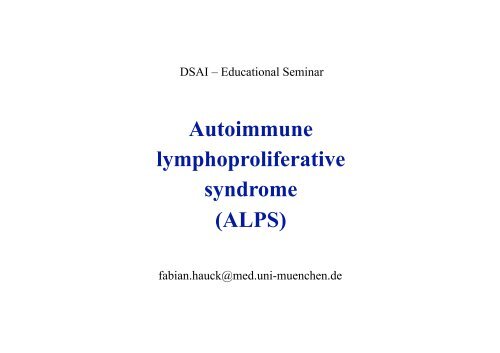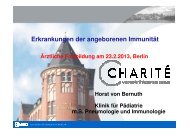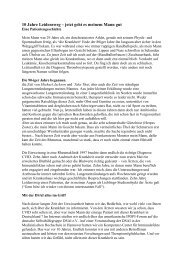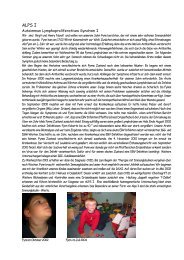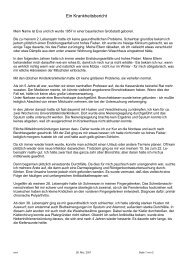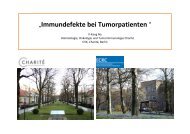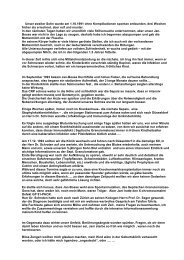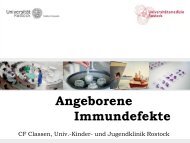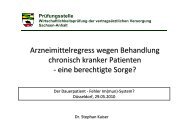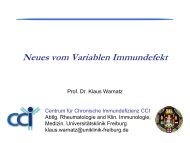Autoimmune lymphoproliferative syndrome (ALPS)
Autoimmune lymphoproliferative syndrome (ALPS)
Autoimmune lymphoproliferative syndrome (ALPS)
Create successful ePaper yourself
Turn your PDF publications into a flip-book with our unique Google optimized e-Paper software.
DSAI – Educational Seminar<br />
<strong>Autoimmune</strong><br />
<strong>lymphoproliferative</strong><br />
<strong>syndrome</strong><br />
(<strong>ALPS</strong>)<br />
fabian.hauck@med.uni-muenchen.de
• Girl at 6 years with chronic lymphadenopathy and splenomegaly in 2008<br />
• No infectious or malignant cause<br />
• Hemolytic anemia with autoantibodies against erythrocytes<br />
• Thrombocytopenia with autoantibodies against platelets<br />
• IgM reduced, IgG and IgA increased<br />
• Elevated TCRαβ + CD4 - CD8 - double-negative T cells<br />
• sFASL and IL-10 increased<br />
• Father at 8 years with chronic lymphadenopathy and splenomegaly in 1974<br />
• No infectious or malignant cause<br />
• Hemolytic anemia at the age of 8 years stopped after splenectomy<br />
• Lymphadenopathy vanished later on<br />
Medical history
I<br />
II<br />
III<br />
III<br />
1 2<br />
1<br />
3<br />
8 9<br />
Pedigree<br />
10<br />
4 5 6<br />
1 2 3 4 5 6 7<br />
7
Adaptive immunity
Immunity / Autoimmunity / Malignancy
FAS:FASLG central for homeostasis of the immune system
T cell proliferation and apoptosis<br />
are carefully counterbalanced
<strong>Autoimmune</strong><br />
<strong>lymphoproliferative</strong><br />
<strong>syndrome</strong><br />
(<strong>ALPS</strong>)
Revised classification of <strong>ALPS</strong><br />
Nomenclature Gene Definition<br />
<strong>ALPS</strong>-FAS FAS<br />
<strong>ALPS</strong>-FAS FAS<br />
<strong>ALPS</strong>-sFAS FAS<br />
<strong>ALPS</strong>-FASLG FASLG<br />
<strong>ALPS</strong>-CASP10 CASP10<br />
Unknown Unknown<br />
Patients fulfill <strong>ALPS</strong> diagnostic criteria and have<br />
germline homozygous mutations in FAS<br />
Patients fulfill <strong>ALPS</strong> diagnostic criteria and have<br />
germline heterozygous mutations in FAS<br />
Patients fulfill <strong>ALPS</strong> diagnostic criteria and have<br />
somatic mutations in FAS<br />
Patients fulfill <strong>ALPS</strong> diagnostic criteria and have<br />
germline mutations in FASLG<br />
Patients fulfill <strong>ALPS</strong> diagnostic criteria and have<br />
germline mutations in CASP10<br />
Patients meet <strong>ALPS</strong> diagnostic criteria;<br />
however, genetic defect is undetermined<br />
• Strongly dominant negative intracellular domain (ICD) mutations<br />
• Weakly dominant negative extracellular domain (ECD) mutations<br />
• FAS Haploinsufficiency ???
1.<br />
2.<br />
Revised diagnostic criteria for <strong>ALPS</strong><br />
Required<br />
Chronic (> 6 months), nonmalignant, noninfectious<br />
lymphadenopathy or splenomegaly or both<br />
Elevated CD3 + TCRαβ + CD4 − CD8 − DNT cells<br />
(≥ 1.5% of total lymphocytes or 2.5% of CD3 + lymphocytes)<br />
Primary accessory<br />
1. Defective lymphocyte apoptosis<br />
2. Somatic or germline pathogenic mutation in FAS, FASLG or CASP10<br />
1.<br />
Secondary accessory<br />
Elevated plasma sFASL (>200 pg/mL) OR interleukin-10 (>20 pg/mL) OR<br />
vitamin B 12 (> 1500 ng/L) OR interleukin-18 (> 500 pg/mL) levels<br />
2. Typical immunohistological findings<br />
3. <strong>Autoimmune</strong> cytopenias AND elevated immunoglobulin G levels<br />
4.<br />
Definitive diagnosis needs 2 required plus 1 primary accessory criteria<br />
Family history of a nonmalignant/noninfectious lymphoproliferation<br />
with or without autoimmunity
Heterozygous germline start codon FAS c.3 G>T<br />
in 12/19 but only 2/12 with full-blown <strong>ALPS</strong><br />
I<br />
II<br />
III<br />
III<br />
1 2<br />
1<br />
3<br />
8 9<br />
10<br />
4 5 6<br />
1 2 3 4 5 6 7<br />
7
LOH in DNT leads to <strong>ALPS</strong>-FAS/sFAS<br />
Control<br />
II.6<br />
Father<br />
III.6<br />
<strong>ALPS</strong>-FAS/sFAS<br />
PBMC DNT<br />
CCATGCTGG CCATGCTGG<br />
CCATG/ TCTGG<br />
CCAT G/ T CTGG<br />
CCAT G/ TCTGG CCATTCTGG
Summary<br />
• <strong>ALPS</strong> is caused by defective lymphocyte apoptosis<br />
• <strong>ALPS</strong> is diagnosed with clinical, laboratory and genetic criteria<br />
- Lymphadenopathy<br />
- Splenomegaly<br />
- <strong>Autoimmune</strong> cytopenias<br />
- Elevated double-negative T cells<br />
- Elevated biomarkers (sFASL, IL-10, vitamine B12)<br />
- Disturbed apoptosis<br />
- <strong>ALPS</strong> defining mutations, e.g. in FAS
Summary<br />
• Start codon FAS c.3 G>T is impeeding expression from the<br />
affacted allele<br />
• No interfeering protein expressed<br />
• MPR present sub-clinical manifestation<br />
• Somatic LOH in DNT causes full-blown <strong>ALPS</strong>-FAS/sFAS<br />
• In vitro apoptosis not suitable for diagnosing <strong>ALPS</strong>-sFAS<br />
• FAS on DNT should be analyzed routinely<br />
• FAS haploinsufficiency does not cause <strong>ALPS</strong>-FAS<br />
• Haploinsufficient patients have to be monitored<br />
• Without interferring FAS protein a second genetic or<br />
environmental hit may always be necessary in the pathogenesis of<br />
<strong>ALPS</strong>-FAS/second hit


